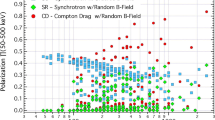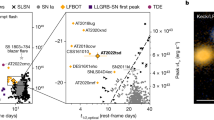Abstract
The increased sensitivity, sky coverage and spectral range of X-ray observatories have revealed a wide range of transient phenomena. The ‘classical’ X-ray transients flare rapidly, sometimes increasing by more than an order of magnitude in X-ray flux in a matter of days, and decay on time scales of months. Such transients are mainly located in the galactic plane, often associated with ‘steady’ X-ray sources1. Some high galactic latitude transients, most of which are optically unidentified, have been observed to vary on time scales of tens of seconds to days2,3. Most transient sources have been detected at energies greater than 1 keV; more recently, however, softer X-ray transients have been detected with observations on HEAO 1 and other satellites4–9. We now report detection of a new soft X-ray transient, H1853 + 60, using datafrom the low energy detectors (LEDs) on the HEAO 1 A-2 experiment.
Similar content being viewed by others
References
Willmore, A. P. Proc. R. Soc. A350, 463 (1976).
Johnston, M. D., Griffiths, R. E. & Ward, M. J. Nature 285, 26 (1980).
Schrijver, J. et al. Astr. Astrophys. 69, L1 (1978).
Rappaport, S., Cash, W., Doxsey, R., McClintock, J. & Moore, G. Astrophys. J. Lett. 187, L5 (1974).
Mason, K. O., Lampton, M., Charles, P. & Bowyer, S. Astrophys. J. Lett. 226, L129 (1978).
Heise, J. et al. Astrophys J. Lett. 202, L73 (1975).
Kahn, S. M. et al. Astrophys. J. Lett. 234, L107 (1979).
Nousek, J., Cardova, F. & Garmire, G. Astrophys. J. (in the press).
Jensen, K. & Nousek, J. Bull. Am. astr. Soc. 12, 820 (1980).
Marshall, F. E. et al. Astrophys. J. Suppl. 40, 657 (1979).
Pettersen, B. R. Inst. Theor. Astrophys., Blindern-Oslo Rep. no. 46 (1976).
Joy, A. H. & Abt, H. A. Astrophys. J. Suppl. 28, 1 (1974).
Gorenstein, P. & Tucker, W. H. A. Rev. Astr. Astrophys. 14, 373 (1976).
Kahn, S. M. et al. Astrophys. J. Lett. 234, L107 (1979).
Underwood, J. H. et al. Prog. Aeron. Astr. 48, 179 (1976).
McCombie, W. J. & Rust, D. M. Sol. Phys. 61, 69 (1979).
Swank, J. H., Boldt, E. A., Holt, S. S., Rothschild, R. E. & Serlemitsos, P. J. Astrophys. J. Lett. 226, L133 (1978).
Kukarkin, B. V. et al. General Catalog of Variable Stars and supplements (Nauka, Moscow, 1969–74).
Author information
Authors and Affiliations
Rights and permissions
About this article
Cite this article
Stern, R., Agrawal, P. & Riegler, G. The very soft X-ray transient H1853 + 60. Nature 290, 573–574 (1981). https://doi.org/10.1038/290573a0
Received:
Accepted:
Issue Date:
DOI: https://doi.org/10.1038/290573a0
- Springer Nature Limited





